Think like an Animal
As human beings, it's easy to put ourselves in the shoes of other human beings. When we see someone crying we feel there pain, when we see someone laughing, we can vicariously understand that same feeling of joy. Doing so with animals, however, is much more complicated. It takes decades of studying and understanding to gain insight into the ways in which animals think and comprehend the world around them. A recent study conducted on dolphin communication using data collected over a 25 year period helped scientists determine that when separated dolphins call out to each other using specified 'name' calls.
The research has astounding implications on human-animal interactions. We as humans are a young species and have much to learn about the world we inhabit. Making assumptions about different species is ignorant and unsafe. Temple Grandin, a world renowned professor and animal scientist, approaches her subject matter (in this case cattle) from a scientific standpoint but also from an animalistic stand point. The later of the two is extremely important and often overlooked in her field. When trying to comprehend what cattle go through in large scale meat processing operations she goes inside to examine factory interiors. Understanding the meat processing experience from a 1,200 pound steer's perspective is a fundamental part of what Temple does. She talks about distractions in processing plants that she visited: coats, shadows and sounds that could have frightened cattle. She understands cattle on a holistic level and not simply as a commodity. Viewing cattle as individual animals instead of masses of meat is crucial to changing the American perspective on food.
This brings us back to one of our focal points touched on throughout the Young Farmer Screening Series, which is getting to know your farmer and your food. When people buy packaged beef from the grocery store, they are so far removed from where the beef actually came from it's easy to look the other way and buy value beef over humanely/sustainably raised beef. Getting back in touch with where our food comes from is vital to bringing us back to the way our grandparents used to eat. Understanding that a cow is a cow and not simply food will bring greater appreciation for what is on our plates along with the people who helped put it there.
Chico to SMU
Late Monday night Andy came down w a 24 hour flu, so drove out to Chico in the morning solo. Chico is a rural small town, with a lot of semi trucks and no motels. Brad Bound is the upbeat optimistic FFA instructor there who hosted us for two class periods, with about 40 students all told, with a break in between.
Monday
We drove North and West to Decatur HS where Mr. Goggins, a young FFA instructor awaited.
With my Daughter, in the field
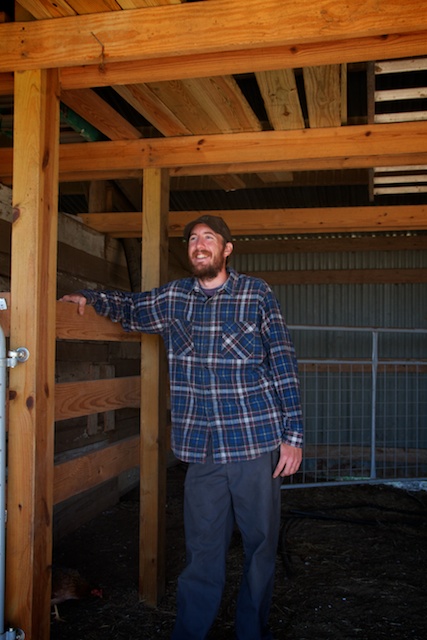
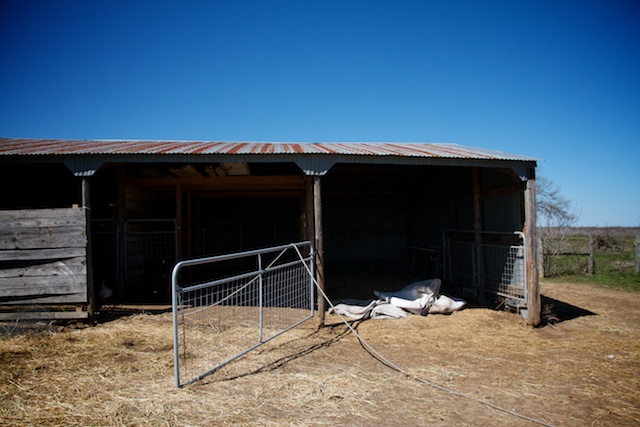
Lunch at the Cafeteria
A lot of us are a bit fried, a bit behind, stressed by something. And then once in a while someone enters the picture who is miraculously unhurried, relaxed and reflective. Despite teaching 4 classes on Friday, Dr. Keith Whitworth at Texas Christian University greeted us at 11am and walked us through the purple-filled tree-lined campus towards the cafeteria, where he was kind enough to treat Andy, I, Nate and Rachel, one of his students to lunch. The campus food service is done by Sydexo, one of the larger food providers in the country. Rachel, who elected to join us, wanted to know what she could do to have a positive impact. The student community garden was suggested as a good place to start.
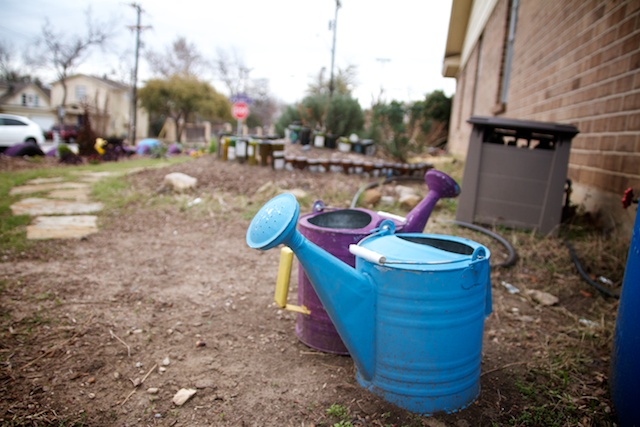
All a little on edge after hearing about the meteorites hitting Russia, we joked that the asteroid predicted to come closer to Earth than any in recorded history, would hit during our screening of American Meat.
Met up w Claire Cummings of BAMCo, and the 5 of us took turns walking together, discussing various things like jobs, life paths, and horned frogs, the spiky little amphibian that serves as the mascot for the university. Before the screening, Keith showed us the community garden that he had helped start, a smallish plot that's part of the church on campus. Some hearty kale and chard remained, and two massive rainwater cisterns captured all the downfall from the roof. Claire tossed her apple core in the compost bin.
We only had 50 minutes so that meant we had to skip ahead. Claire and I gave brief intros and then we showed some scenes from the beginning, middle and end of the movie. Talk about a spoiler. Students were engaged and we talked about the impact of technology on modern rural America, as well as some of the reasons that some companies are starting to look to local distribution models for a number of reasons.
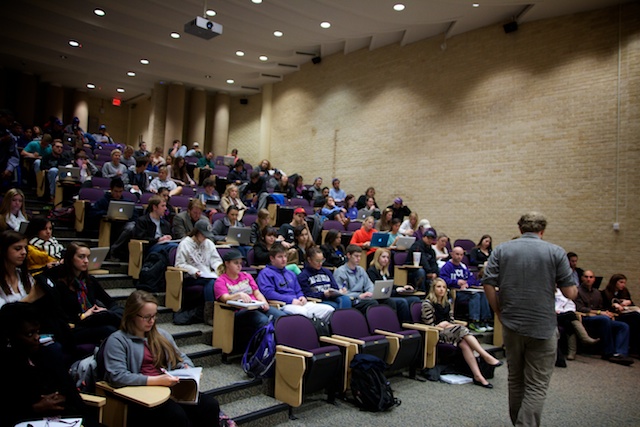
Apparently the 140 in the room was a very large class for the relatively small campus of 10k. I probably talked a bit too much, but at least Claire got to get in the last word of the day. Nate from Chipotle gave out some free shirts and we were a bit surprised at how raucous the efforts to obtain these cotton garments were. Again, the mystical power of free stuff.
We said goodbye to the kind and relaxed Dr. Whitworth and to everyone else and headed back South to Austin.
Rabbit Rancher
Thursday we started off at Plano West High School, one of 6 or so high schools in the sprawling Plano, which is in turn part of the larger and yet more sprawling Dallas/Ft. Worth area.
A couple of classrooms combined, Dyan and Robin's classes respectively, for two consecutive mid-morning classes of about 50 each. We only had 50 minutes so we showed excerpts of the documentary, the introduction, the scene outlining the 2008 hog market crash, and we ended on the solution oriented segment from Polyface.
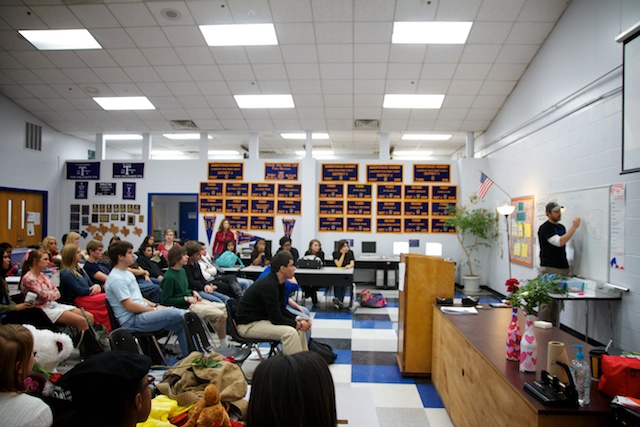
The students were respectful, watching intently and engaging in conversation following, conversation that spanned the advantages and disadvantages of conventional systems, and new grass-based local ones. Students were ecstatic to discover that they each got a burrito coupon, and even cheered at the news. The strange and haunting power of free stuff.
We said goodbyes and thankyous, and headed out to our first shoot for the Young Texas Farmers portion of the tour. The shoot was at the Lisle household, just over yonder hill from the Ft. Worth city limits. we assured the good-natured and protective father Phil, that we were pro-farmer folks, and shortly thereafter Andy began filming as Katie and her younger sister Kendall did chores in the old red barn. Chores means checking in on the hundreds of rabbits, and making sure they've got plenty of water, food, and that if there are any that didn't make it, they get cleared out. I talked with Phil as they filmed, it being midday and the sun harsh in the cloudless Texas afternoon. Phil clearly had a passion for rabbits, a passion transferred to both his daughters Katie and Kendall.
We flipped over some empty milk crates behind the rabbit barn and started the interview. Katie, only 18, has charisma beyond her years. Her passion for raising rabbits is strong. She raises rabbits for shows, where people can win ribbons for demonstrating certain characteristics in certain breeds. Katie is so focused on winning that it is what she thinks about most when walking into the barn each day. She's headed to Tarleton State this fall and plans to start a rabbit club with ambition to replace or at least have rabbit join chicken as the other white meat. She pointed out that rabbits together mature faster than chickens, and their manure is better fertilizer than chicken manure because it isn't as acidic. She spoke of how she will raise rabbits for the rest of her life, and that she wanted to be a professional judge in 5-10 years. Both Andy and I agreed later on that we thought she would achieve her goals because of the voracity of her belief.

After the interview, we visited with all of the Lisle's, laughing about how when Katie was only in 4th grade she picked out the family's house, which sits across the street from the elementary school where Katie looked out and saw a for sale sign. Phil has always wanted a farm, and his better half, always been a city girl, so this home straddling the city and country with a barn full of rabbits and a pool seems like a fitting compromise.
We said goodbye and headed to a sketchy Motel 6 after eating at a good dinner spot in Ft. Worth.
Eat More Beef?
Eat more meat? Joel Salatin is known for his interesting sometimes even outrageous comments so it should come as no surprise that when posed with the question, 'should we eat more meat?' his answer is yes...
Read moreMaking Positive Changes, by a student at Redlands University
The American Meat film screening and panel discussion at the University of Redlands on January 31, 2013 was a major success in terms of educating a large audience and building community in Redlands.
The panel discussion brought together people with different perspectives and backgrounds with a common interest in creating sustainable alternatives to the current practices of the meat industry. Panelists included Carrie Anne Parker, owner of the local business Rolling Hills Herbs and Annuals, Marc Powers the head chef at Bon Appetit dining services on campus, Daniel Klooster, and environmental studies professor with a particular interest in food sustainability, and myself, a the Sustainability Representative in the Associate Students of the University of Redlands. Graham Meriwether did a fantastic job of both moderating the event and sharing his perspective as someone directly involved with the making of the film.
Many of the questions pertained to how we can work towards a more sustainable future regarding food in Redlands. The panelists were able to share insights about the availability of local fresh food and Redlands and ways to reduce industrialized meat consumption. Carrie Anne spoke about how her family only consumes local, ethically raised meat. Because this type of meat is more expensive, her family consumes meat significantly less frequently than an average American family. There is a misconception in this country about how much protein we need in a healthy diet to sustain us. Additionally, many fruits, vegetables, grains, nuts, and seeds are protein-rich and the nutritional value of non-meat protein often is unrecognized and undervalued in our society.
Marc Powers spoke about how he cooks large meals for his family and has learned to use recipes that make less meat go a longer way. This technique saves his family lots of money, and they get to enjoy his skillful home cooking on a daily basis.
Both Daniel Klooster and I spoke about the abundance of local, fresh food available in the area. Living in Southern California, we are fortunate enough to have the ability to grow almost anything for the whole year. Food can often grow during the winter season because of the abundance of rain and the rarity of freezing temperatures. There are at least three weekly farmers markets in the area.
Collectively, the panel referred to several grassroots groups that have gathered in Redlands in order to combat environmental and social problems, including the Redlands Sustainability Network, Slowfood Redlands, Occupy Redlands, and the Good Neighbor Coalition.
The panel helped the audience to comprehend how our actions as individuals and collective efforts in the community, can make positive changes towards a more sustainable future in regards to food consumption. As a whole, the event was incredibly successful and we are grateful to have had the opportunity to work with the Leave It Better organization.
Agriculture Creates Community
Spent a couple hours at Black Walnut Café, and found ourselves close enough to the theater to walk. The sunsetting and a beautiful row of old mossy trees along University Ave.
Dry Bones generously provided food, free for everyone, and lots of people, especially adolescents flocked in to partake in the wonderful sustenance that included crackers, tabouli-like spread, and incredible, phenomenal 5 onion soup. So good. Wanted to talk to the fellow, however, he was so passionately preparing and arranging the food, a window never came.
A late arriving crowd of about 175 filled into seats, our film honored to be part of a monthly Green film series at Rice, that is partnered with Transition Houston. It's a beautiful theater, and an intimate setting for a conversation despite the decent capacity.
We greeted Bon Appétit Management Company's Claire Cummings, the West Coast fellow, who's joined us on panels at Seattle Pacific and Gonzaga in Washington state. We caught up through whispers during the film, and were lucky to be a part of a profound discussion following.
Sena is a student at Rice who started an organization called Real Food Revolution. She spoke about setting up events where students get to try food, and then learn about where the food came from. Sounds like fun.
Claire talked about having a great job, getting to go around and work with college students at BAMCo campuses to set up events that raise awareness about the food system and what students can do to change it. David, who runs the in-house food service at Rice, was a super kind man who humbly mentioned that if he were to ever work for another company in food service, BAMCo would be it. He mentioned that they source local when the can, but that there are indeed budget limitations, and seasonal limitations for the thousands of fruits, vegetables, meats, sauces, etc. that are on the inventory of any college food provider.
The evening came to a close on a question about what teachers can do to inspire young people to get into agriculture. Geoffrey Smith, of Barry Farms, gave an answer to be remembered. He said one way to inspire young people is to truly believe every word you say, and believe in every action that you make. He talked about how he and his wife, decided that they could do better. That they could opt out of the grocery store and grow food for their family. What started with one hog has grown to many more, what started with one plot of land, is turning into a strong will to build a community. Geoffrey talked with a slight tremor in his voice, the passion and authenticity of his emotions clear. He said that all of us create our country's agriculture, that over the years, so many of us have moved into subdivisions or apartment buildings in which we do not know our neighbors names, in which we are sealed off from the places where we live, and the people around us stop being communities. He pointed out that our food, and our agriculture have followed this path, removed from community, food manipulated and wrapped in packaging that protects it from everything else, that shuts it off. And how our agriculture is doing the same. Huge machinery that forces more and more people out of rural communities, our nation's heartland too often an endless repetition of corn and soybeans while each week another rural high-school closes down, youth and resources consolidated into another district.
But Geoffrey, and his wife, put their foot down. Decided to start something new. They got a pig and an acre and started to grow, to have meals with people in the community, to learn their neighbors names, to break down the walls, visible and invisible that our culture and our agriculture have been weaving between us unintentionally.
There was a sense of purpose in the air as the conversation ended and a sense we've felt on this journey, that the tide is shifting, the pendulum is swinging, that something bigger and more powerful than the quarterly earnings of a three-letter abbreviation on a stock index can articulate. Farms are growing, people are growing, communities are beginning to sprout.
Single Source
Drove a couple hours to Houston, where we grabbed a great lunch at Local Foods before being hosted by Kayla, and the Student Nutrition Association, an intimate gathering of about 15 people who took time out of a busy afternoon class schedule to watch the documentary and talk following. Ray Law, a cattleman who sells direct to folks in 4 Houston area farmers markets talked about his dislike for government, and his desire to sell directly to customers. One of the panelists, a professor whose name escapes, talked about how she has trouble trusting something unless she can be confident that it has been inspected, labeled, and sealed.
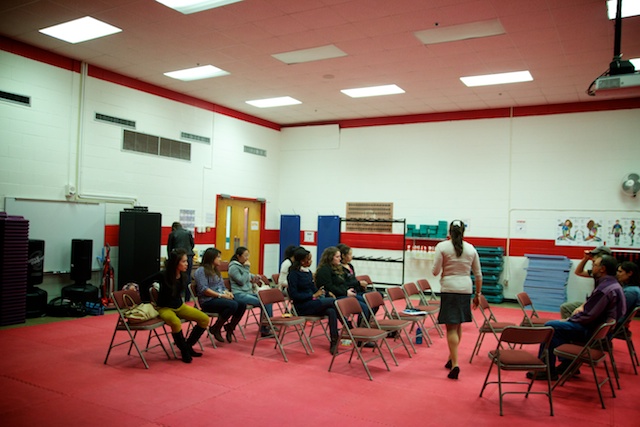
Mentioned that often the biggest recalls come from the packages in the grocery store. That often a package of ground beef in the cooler of a grocery will contain hundreds, perhaps of thousands of different animals in one package. The more animals that are in your burger, the better chance that one of those animals was sick. Ray pointed out that if you buy ground beef from him, it's coming from one animal, a single source, and because it is being slaughtered in a much smaller facility, the animal will get a more thorough inspection than a place where thousands upon thousands of carcasses swing by in a few hours. A simplification perhaps, however, it is hard to disagree with the basic premise.
The professor agreed that she trusted farmers, and mentioned that she will eat meat that has been hunted because she knows the animal lived a natural life in God's creation. We said goodbyes and thank yous and headed out to find a place to camp out before tonight's screening at Rice.